Mastering is the final step in music production. The mixed stereo file goes through the process of mastering for final polish of the vocal and instrumental recording. This is to ensure that the audio gets its listenability features with the potential to provide an enjoyable experience for its listeners.
Ever listened to an old song that suddenly sounded crisper, clearer, and somehow more alive than you remember? That’s the tough of audio remastering that differentiates.
Whether you’re a music producer, podcaster, or just someone with a killer demo from five years ago (yet can’t publish), you’ll learn how to bring your tracks up to today’s standards, without needing a studio or mastering gear.
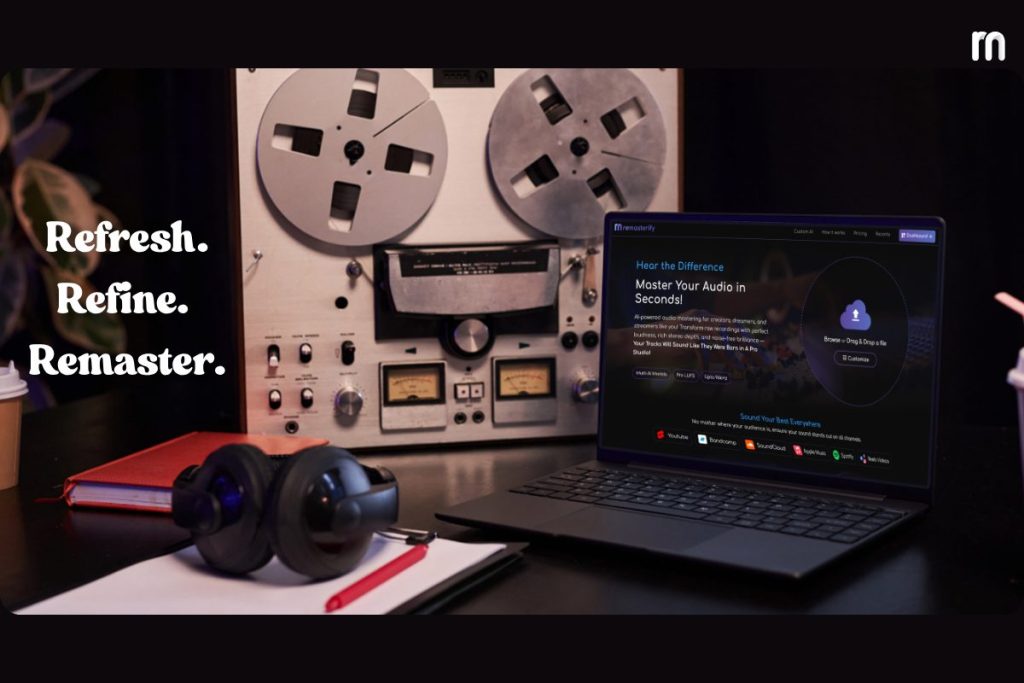
In this blog, we’re diving deep into what audio remastering really means, how it transforms the listening experience, and, most importantly, how you can do it yourself in just minutes using AI tools. You’ll learn:
Table of contents
- What is Audio Remastering?
- What Does Remastering Actually Do to a Soundtrack?
- How does Remastered song impacts the Listening experience?
- How AI Is Making Audio Remastering Easier Than Ever?
- Ways to remaster a song in minutes using Remasterify?
- Frequently Asked Questions
What is Audio Remastering?
Let’s keep it simple. Audio remastering is the process of taking an existing song, usually one that’s already been mastered and released. The goal is to make it sound better using newer techniques.
So, what is a remastered song, exactly?
A remastered song is a new version of an original recording that’s been updated to match modern audio standards. It’s like giving your recording a fresh coat of paint if you want it to be brighter, smoother, and more detailed. In other words, it’s actually making a creation more suitable to the newer age, without changing the original characteristics.
Why Remaster at All?
In the 80s orn90s, tracks were recorded on analogue tape. Back then, mastering engineers were working with gear that couldn’t capture the depth or sharpness that today’s listeners expect. Even great compositions or lyrics from that era can sound flat, muddy, or too quiet by today’s standards. It’s simply because of the timely adaptation of our ears by listening to songs of the current decade.
If you remaster them now, you have to hire a producer to:
- Adjust the EQ balance
- Remove unwanted noise
- Add clarity to the high frequencies
- Enhance stereo imaging
Otherwise, if you spend hours after hours doing it on your own, you’re an aspiring producer.
Not Just for Vintage Tracks
Audio remastering isn’t only for old hits. Even modern artists remaster music from past albums to get them ready for streaming platforms, or to fit better in playlists alongside today’s releases.
In a nutshell, if your song was mixed years ago, chances are it sounds different compared to current releases on Spotify or Apple Music. Remastering brings it up; eventually makes it louder, cleaner, and more polished.
What Does Remastering Actually Do to a Soundtrack?
A lot more than you might think. The goal is to take an original recording and refine it, without changing the soul of the performance. It’s like cleaning a dusty window so you can see the view more clearly.
Here’s the process:
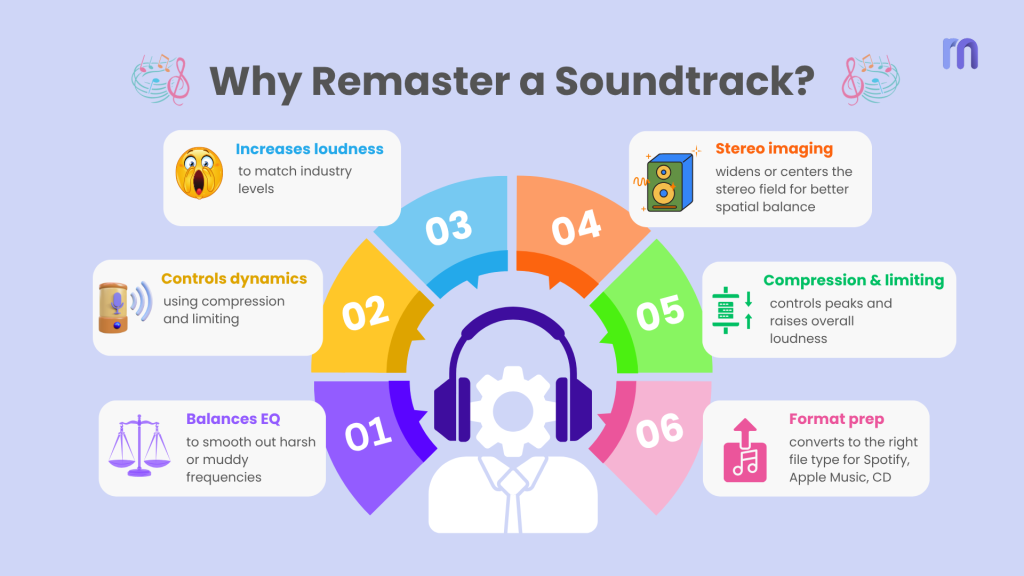
Improved EQ Balance
A well-balanced song isn’t too bassy, too sharp, or too dull. With remastering, engineers or AI tools (whoever or whatever you employ) carefully adjust the EQ balance. This makes sure the high frequencies (like vocals and cymbals) don’t pierce, and the low-end (like kick drums or bass) doesn’t overpower the mix.
Example: If your original mix sounds too boomy on headphones, remastering can tame that bass and make it more pleasant across all devices.
Louder Without Distortion
Streaming services often favor loudness, and so do music lovers. But just turning up the volume can crush the dynamics (like breaking pixels of a low-quality image while zooming in). A good audio remastering process uses smart compression and limiting volume to increase volume without distorting the track or losing detail.
Enhanced Stereo Imaging
Remastering can open up the mix by widening the stereo imaging. This makes instruments feel like they’re placed more naturally in space, and so the listener enjoys the music more. That means more separation, clarity, and impact when people listen.
Example: A guitar that once sat quietly in the center (while unmastered) might now shimmer off to the left, creating a more immersive experience (after mastering with the right tool/ engineer).
Noise and Hiss Removal
Especially in songs recorded on analogue tape, there might be background hiss or hum. Remastering now helps clean that up. Actually, an ideal mastering process includes using noise reduction tools. But don’t worry, this will never ruin the tone of the original track.
Modern Sound Standards
Music changes, and so does the pattern of our listening habits. What sounded “professional” in 2005 might feel dull today. Audio remastering brings your song up to current expectations, so it sounds great whether you’re streaming on a phone, playing it on studio monitors, or using earbuds.
In short, remastering takes a song that already works and makes it shine. You keep the emotion, the performance, the soul, while giving it the polish it deserves.
How Remastered Song Impacts the Listening Experience
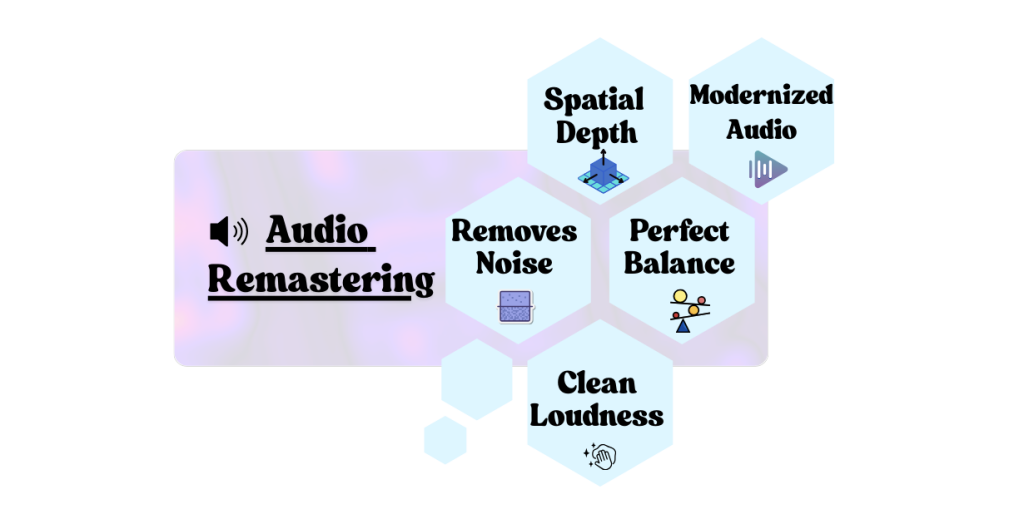
The target of audio remastering is to make a song more emotional that touches the audience. A remastered song feels better. The details are made sharper, the energy is stronger, and the sound wraps around you in a way that the original recording sometimes just can’t.
You Hear More—Even in the Quiet Moments
Ever played a song where the chorus hits hard, but the verses feel weak? With proper remastering, the entire track becomes more consistent. Volume levels are smoothed out, and quiet parts still feel full and alive.
That’s because audio remastering balances dynamics without squashing the soul of the music.
A Fuller, Richer Sound on Any Device
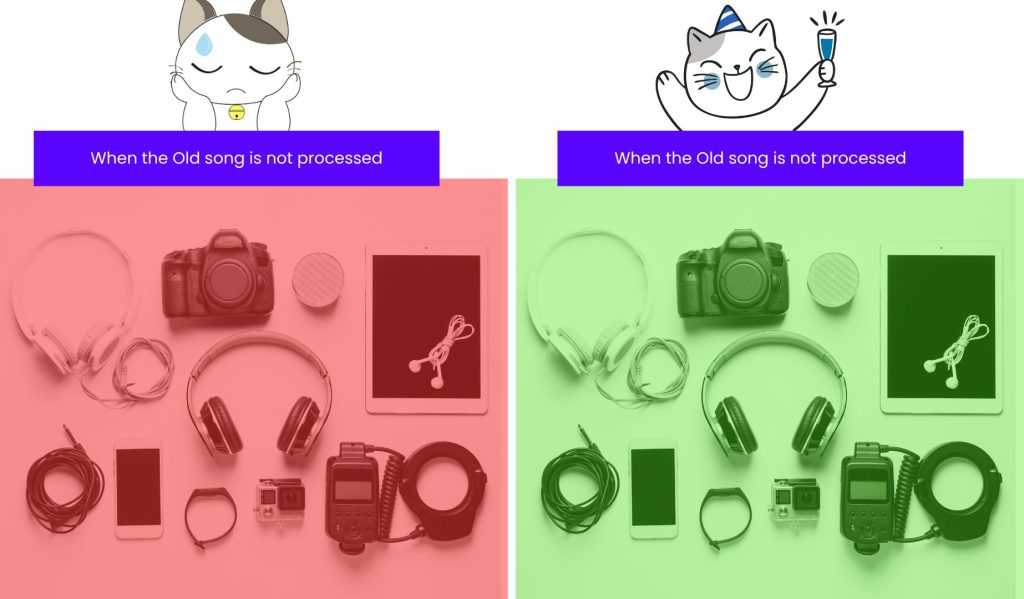
One of the biggest advantages of a remastered song is how it sounds across different playback systems: headphones, Bluetooth speakers, or car stereos. Remastering improves stereo imaging, adjusts EQ balance, and makes sure high frequencies stay clear (not harsh), no matter where you’re listening.
You may have experienced that an older rock track might sound flat on your phone. Once you remaster that, that same track suddenly has bite, and punch.
Streaming Services Love Loud and Clear
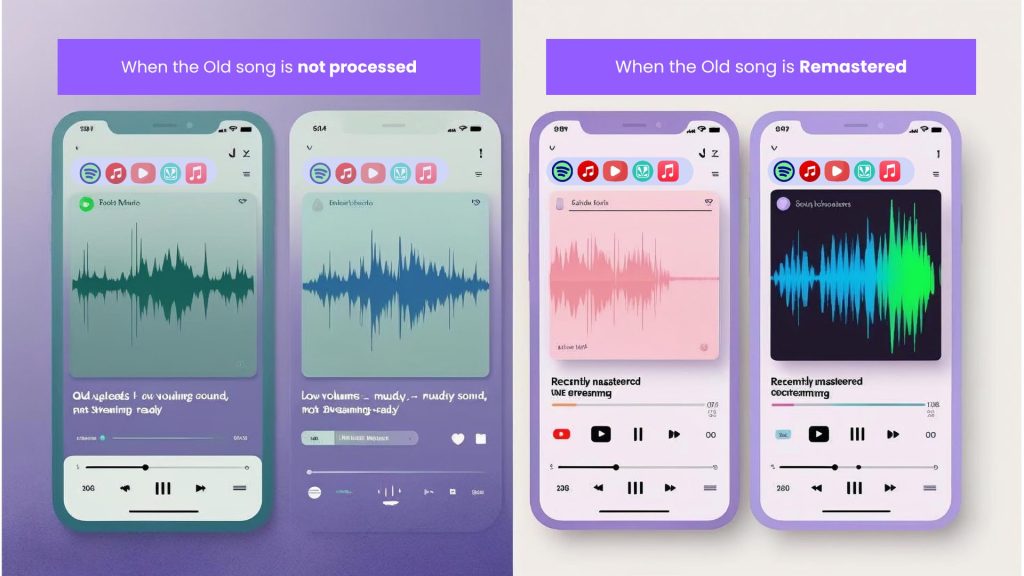
If your music is going on Spotify, Apple Music, or YouTube, you need to meet their loudness and clarity standards. A properly mastered song ensures that your track stands tall next to today’s releases and doesn’t get lost in the shuffle; and that’s why old songs may require a remaster. Mastering.com shares the information for loudness optimization for streaming platforms. Read here.
It Feels Fresh, Even If It’s Old
This is why labels remaster music for anniversary editions or reissues. By using new tools to enhance original recordings, they make familiar songs exciting again. Whether it’s a jazz ballad from vinyl or a rock song recorded on analogue tape, remastering can breathe new life into it.
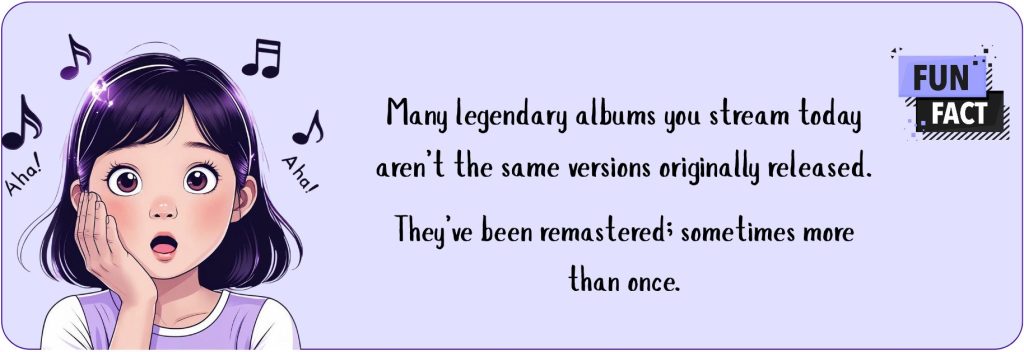
In the end, audio remastering isn’t just about loudness or clarity. It’s about emotion. It’s the reason a remastered song can give you goosebumps, even if you’ve heard it a hundred times before.
How AI Is Making Audio Remastering Easier Than Ever
Let’s be honest—audio remastering used to be a slow, expensive process. You needed access to pro gear, trained mastering engineers, and a room tuned to perfection. It could take days, and if you were an indie artist or podcaster? Forget about it.
But now? You can remaster music in minutes. Literally.
Thanks to AI-powered tools, the remastering process has become faster, smarter, and more accessible than ever.
What AI Tools Actually Do
AI mastering platforms like Remasterify analyse your track using trained algorithms. These tools “listen” to your original recording, compare it to high-quality masters, and then apply enhancements, just like a human would, but in seconds.
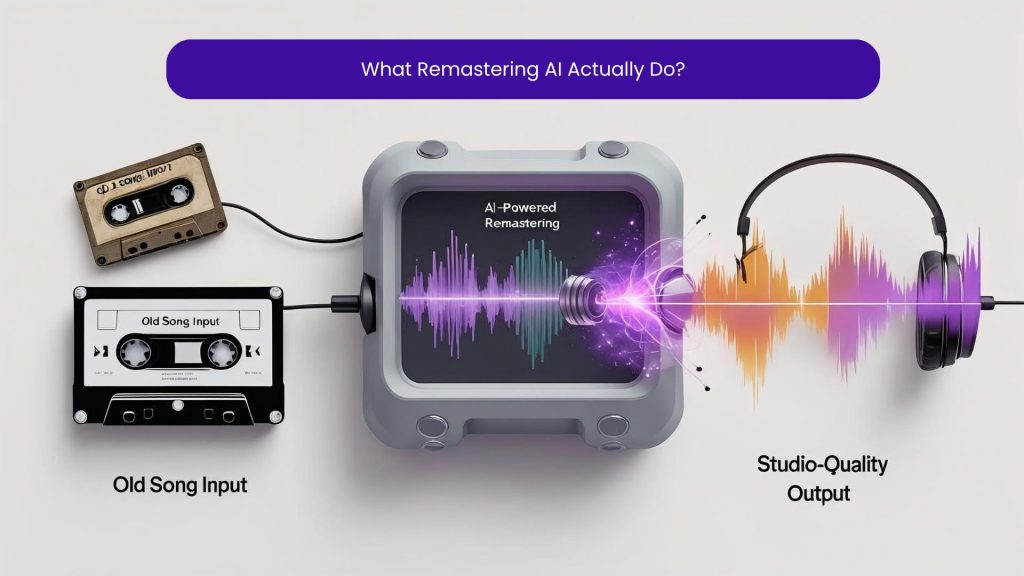
Here’s what’s happening behind the scenes:
- Adjusting the EQ balance to make the track sound full
- Boosting high frequencies to add sparkle without harshness
- Enhancing stereo imaging to make the mix feel wide and deep
- Managing loudness and compression so it sounds modern and punchy
- Reducing noise that may have come from old gear or analogue tape
Who AI Remastering Is Perfect For
Whether you’re a solo artist, beatmaker, or podcast host, AI tools level the playing field. No more waiting on mastering studios or paying hundreds per track.
Example: You record a song at home, upload it to Remasterify, tweak a few settings, and boom, you’ve got a remastered song ready for Spotify.
It’s fast, affordable, and shockingly good. In fact, many creators can’t tell the difference between a human-mastered and an AI-mastered track, especially when the original mix is decent.
With all that power packed into just a few clicks, it’s no surprise that AI is changing how we remaster music, and fast. So, how do you actually do it? Let’s go through the simple steps to create a remastered song using a tool like Remasterify.
Ways to remaster a song in minutes using Remasterify
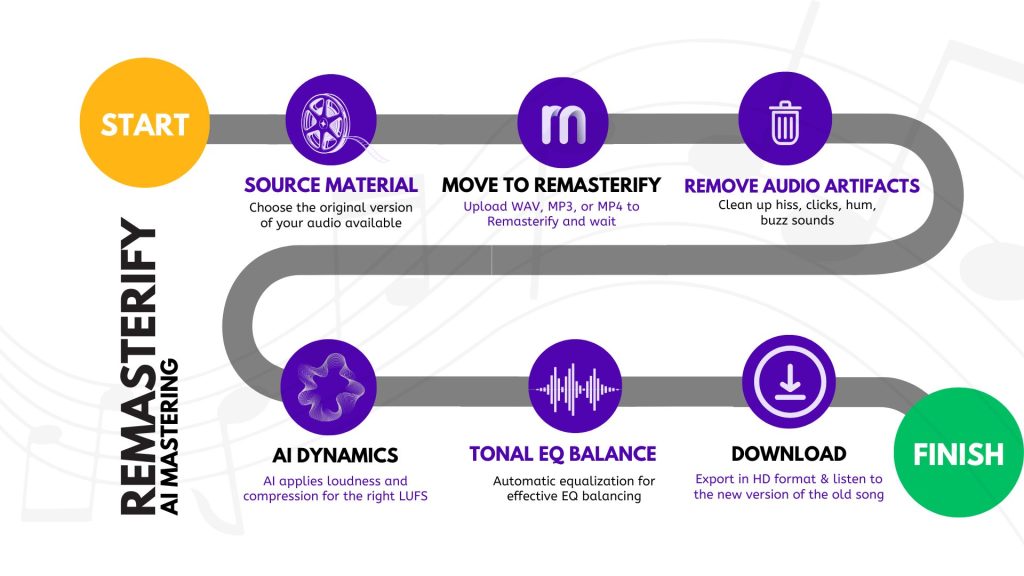
Gone are the days when audio remastering meant sitting in a studio with racks of gear and a team of mastering engineers. With tools like Remasterify, you can take your original recording and give it a professional finish—all from your laptop.
Here’s how easy it is:
Step 1: Upload Your Track
Head over to Remasterify and drag in your audio file. For best results, use a high-quality file like WAV. Even if it’s a track recorded years ago on analogue tape, the AI can still work wonders with it.
Step 2: Choose Your Settings
Once your file is uploaded, Remasterify gives you the power to customize how your final remastered song will sound. But don’t just click around—here’s how to use each setting strategically:
Mastering Intensity
- Light – Perfect for acoustic, jazz, lo-fi, or podcast-style audio. This keeps dynamics natural and avoids over-processing.
- Medium – Best for pop, indie, or singer-songwriter tracks. Adds a nice punch without sounding too aggressive.
- High – Ideal for EDM, hip-hop, or anything that needs to be loud and polished. Use this to compete with commercial releases.
Strategy: If you’re unsure, start with medium. You can always adjust after previewing.
EQ Balance
- More Bass? Boost the low end slightly if your mix feels thin. But avoid going too far—it can quickly sound muddy.
- More Clarity? Raise the high frequencies to add sparkle, especially to vocals or cymbals.
- Automatic Equalization Setting: This is your safest bet if the mix is already well-balanced.
Strategy: Compare your original recording to current songs in your genre. If your mix feels dull in comparison, it probably needs a boost in the highs or mids.
Stereo Imaging
- Tighter Imaging: Keeps everything centered and is great for voice-heavy audio like podcasts.
- Wider Imaging: Pushes instruments outward in the stereo field—ideal for immersive genres like ambient, rock, or cinematic tracks.
Strategy: Use wide imaging for instruments (like guitars and synths) but keep kick, snare, and vocals centered for punch and focus.
High Frequencies Boost
If your mix lacks brightness or feels muffled, this setting can add air and presence.
Strategy: Use sparingly—too much can make a track sound harsh or brittle. Great for lifting up dull mixes recorded on older gear or analogue tape.
Upload a Reference Track
Want your song to sound like a specific artist or hit song? Upload a reference track you love, and Remasterify will try to match the tone and loudness.
Strategy: Use reference tracks that match your genre, vocal style, and energy level—not just your favorite songs.
By using these settings with intention, you’re not just letting AI do the work—you’re guiding the AI to create a master that truly fits your vision.
Step 3: Preview the Remastered Song
Before downloading, you can listen to a preview. Compare it with your original recording to hear the difference. You’ll notice tighter EQ balance, better stereo imaging, and crisp high frequencies—all in just a few clicks.
Step 4: Download and Use
Once you’re happy, download your remastered song. It’s ready to publish, stream, or send to your fans. No extra steps. No studio time. Just great sound.
Pro Tip: You can remaster multiple songs for an entire project in minutes. It’s a huge time-saver if you’re prepping for a release or uploading back catalogue tracks to streaming platforms.
Audio remastering doesn’t have to be complicated. With AI tools like Remasterify, the power to remaster music is right at your fingertips—even if you’ve never touched a mixing board.
Conclusion
You don’t need to be a sound engineer or know how every plugin works. All you need is a good mix, an idea of how you want it to sound, and the right AI tool to bring it to life.
So if you’ve got a song that deserves better, now’s the time to act. Try Remasterify, and see how audio remastering can completely transform the way your music feels—without ever stepping into a studio.
Frequently Asked Questions
Mixing is where you adjust each individual track, like vocals, drums, or guitar. So they sound good together. You balance volume, pan left/right, and apply effects like reverb or EQ. Mastering comes after mixing. It focuses on the final stereo file (the full song) to make it louder, clearer, and ready for release on all platforms. Mastering adjusts overall EQ, volume (loudness), and stereo width. It also ensures your song sounds consistent with other songs on streaming services or albums. In short: mixing blends the parts, mastering polishes the whole.
Mastering makes your song sound professional and consistent across all playback systems, like phones, speakers, or headphones. Without mastering, a track might sound too quiet, muddy, or flat compared to other songs. Mastering balances the frequencies, boosts clarity, adjusts loudness, and gives your music that final “finished” feel. It also ensures your track meets streaming platform standards. Simply put, mastering is what makes a good mix sound release-ready.
Yes, you can master your music without a studio. AI-powered tools like Remasterify let you upload your track, choose a few settings, and get a professional-quality master in minutes. You don’t need expensive gear or deep technical skills. As long as your mix is decent, these tools can enhance it with clean EQ, proper loudness, stereo width, and noise reduction. It’s a simple and affordable way for beginners, indie artists, or podcasters to improve their sound.
A remastered song usually sounds louder, clearer, and more polished than the original. The bass feels tighter, vocals stand out more, and the overall mix has more depth and balance. You may notice better stereo separation (instruments feel more spaced out) and fewer distractions like hiss or hum. Even quiet parts of the song feel full and alive. Remastering doesn’t change the music; it just makes it sound fresher and more modern, especially on streaming platforms or small speakers.
Yes, for most creators, AI mastering is good enough for releasing music. If your mix is solid, AI tools can match loudness, balance EQ, improve stereo width, and make your song streaming-ready. It’s a fast and cost-effective option, especially for indie artists or home producers. While a human mastering engineer might give you more creative control and detail, AI gets close—often indistinguishable to average listeners. It’s perfect for demos, singles, podcasts, or small releases without a big budget.
